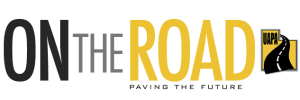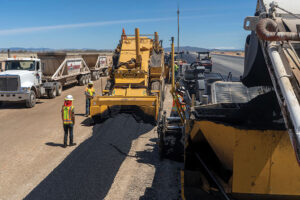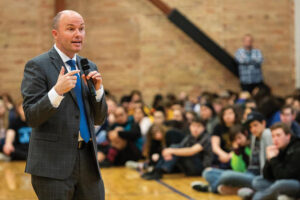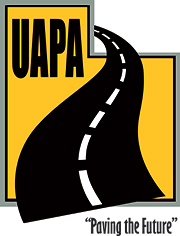By The Utah Asphalt Pavement Association
Natalie Gochnour, the Director of the Kem C. Gardner Policy Institute at the David Eccles School of Business, recently talked about Utah’s economy and COVID-19. The following article is a summary of her insights.
The U.S., including Utah, is currently in the middle of a shutdown recession caused by COVID-19. There is considerable evidence to show that Utah has done better than other states: Utah’s unemployment rate (8.5%) is the second-lowest in the country. The national rate is 13.3%. Utah’s jobs have declined by 4.8% in Utah, but the country as a whole has lost 11.8% of its jobs. The numbers are troubling, but they are better than their national counterparts.
Natalie credits Utah’s success to Governor Herbert’s plan, released March 24, 2020. She sees the pandemic as the equivalent of a body blow that has affected different industries and different people severely and unevenly. Governor Herbert’s color-coded economic phases gave citizens of the state structure and hope. Although she says Governor Herbert is unwilling to shut down the economy again, he is willing to support local control over issues such as face coverings in Salt Lake County. She recommends that people follow public health guidelines, including the use of face coverings.
If Natalie had one piece of advice to give business owners or employees, it would be to wear some kind of face covering. She sees masks as the most effective tool we have to keep the economy functioning while protecting public health. She cited a study that was released in the June 2020 issue of The Lancet. An article about the study made a compelling argument that masks significantly reduce the risk of infection.
In Natalie’s opinion, the worst of the pandemic is over. Job loss peaked in April 2020, and she now expects a gradual recovery that will look more like a gradual Nike swoosh than a V-shape. She says recovery will not be complete until there is a vaccine, which she thinks is most likely to be available by Spring 2021.
The state has written a two-year business plan that started in March 2020. Planning has included consideration of the following scenarios:
- Best-case is a green new normal and rapid access to a vaccine.
- Hot spots and flare-ups could affect geographic areas and specific industries.
One of the difficulties currently facing the state is the uncertainty that exists. Natalie’s approach for uncertain situations is to come up with a plan that heads us in the right direction, and then use incoming information to create iterations of that plan.
The Gardner Institute has, of course, already considered the effect of COVID-19 on the state in the short term; in the long run, she thinks that the pandemic will end, furloughed employees will return to their jobs, masks will go away and life will feel normal again.
Utah is currently still a growth state. The rapid growth areas during the next 20 to 50 years are the “ring counties” surrounding the urban counties, such as Summit, Wasatch, Juab and the southwest counties. The biggest growth engine in the state is located in Utah County. It has Provo and land that is close to the city. She thinks it will be almost as large as Salt Lake County.
The long-term structural changes she sees are the ones that affect Utah’s economic structure. People have been using global supply chains, but they can fall apart because they are unavoidably risky, unpredictable and brittle. Shorter supply chains are inherently more dependable, so she thinks “just in time” will change to “just in case.”
Salt Lake City has huge supply chain advantages: in addition to being in the center of the country, there are enormous transportation assets such as the airport and freeway system. It is ideally situated as a global logistics hub, which means there will be a need for commercial real estate. At the same time, remote work could change the economics of that real estate.
The pandemic will create a new normal for growth and prosperity, with winners and losers as some industries gain advantages and others are hurt as changes in purchasing patterns take place. For example, people are likely to invest more effort in home improvement, nesting and home security for a while. As the restaurant and retail industries dropped, so did the sales tax revenue with them, but home improvement stores saw increases. For example, according to Staker Parson Materials & Construction, a lot of people have recently bought decorative rocks for the landscaping around their houses.
Economically, businesses on the winning side have an obligation to help businesses on the losing side. Tax money has helped with the paycheck protection plan, and many people have bought takeout just to help restaurants. These efforts, including direct payments and funding to help symphonies, operas and museums, are important; when damage is severe, it can be tough to put programs back together again later. Natalie just hopes that everyone had a rainy-day fund to fill in the gaps.
Governor Herbert’s Utah Leads Together plan has four volumes. The fourth volume focuses on economic recovery and revitalization with three horizons: 100 days, 250 days and 500 days.
As far as commercial construction is concerned, the Utah Legislature is always interested in building when economic needs are great and interest is low. They push to accelerate bonding to build important projects, and that includes building infrastructure. The definition of infrastructure is broad; it consists of a wide range of possible projects such as broadband, outdoor recreation, transit, transportation and water. Some projects are ready for construction, and more will be ready soon. For example, the airport will be completing a major milestone in September, and once that milestone is done, there may be a need for many more workers there.
In Utah, 7% of its jobs are currently in construction. That percentage includes UAPA. The value of nonresidential construction in Utah for 2020 was estimated for the governor’s office in late December 2019 to be close to $2.06 billion, but that estimate was made at a time when people had only recently heard the term COVID-19. No one anticipated the shutdown that would take place in March.
The most recent forecast took place in June 2020, and it confirmed that turning off the Utah economy caused a really bad second quarter. As a result, 2019 was a peak year for economic growth, and in contrast, 2020 will show a decline. However, you also have to look at other data. Between May 2019 and May 2020, the fastest industry growth was in construction. Where the entire state saw a 4.8% decline in employment, construction (including road construction) had a 7.3% growth rate.
The construction industry has some advantages when compared with other sectors. It is essential, many construction workers do their work outside, and its high wages have a multiplier effect on the economy. It is a lead indicator because construction can help support other industries.
Having a skilled workforce is the most important way to build the Utah economy. As businesses consider Utah for new locations or expansions, those businesses always consider the cost and quality of labor. A huge part of Utah’s prosperity has been based on the state’s ability to provide a well-trained labor force that is available for work. A major tenet of Utah’s approach is upscaling and rescaling Utah’s job force. Why? Since so many skills are attached to specific jobs, people who have been laid off often need to be retrained.
Many jobs are in the skilled trades. Utah has money and programs to help people learn those trades, but Utah industries have a responsibility to recruit and train potential employees.
Natalie sees an incredible need to unify as a country and as individual citizens. The policy turmoil in Washington D.C. has been incredibly hard on everyone. She thinks we have a responsibility as citizens to come together and solve problems. But how exactly do we do that?
Natalie has been thinking a great deal about the pandemic and structural and behavioral change. Of the two, behavioral changes are harder to create than structural change. She sees the aging U.S. population as something that will cause structural change, and she sees behavioral change as an important way to get rid of the pandemic. Since there is substantial evidence that masks and face coverings make it possible to protect human health while allowing the economy to continue functioning, she sees masks as something that should not be considered political.
Natalie has also been reading everything she can about social justice, racial inequalities, and racist and antiracist policies. For example, she read Just Mercy by Bryan Stevenson because Spencer Cox has been strongly recommending it to people.
The evidence is plain that the U.S. needs to change. The country has racial economic disparities that are especially apparent in the criminal justice system. Natalie talked about a national initiative, announced June 23, 2020, to address inequality of opportunity in education, employment, entrepreneurship and criminal justice reform. On a local and state level, it has become increasingly crucial for members within the construction industry to be involved in finding solutions. That means volunteering time, engaging in the effort to find answers, making sure decision-makers know your point of view, and being willing to listen.
Why is listening important? Listening is a behavioral change. As such, it is difficult. But being defensive about past actions is not going to be enough going forward. Solutions will only become apparent if we are willing to be reflective, to examine our behavior, to listen, and then to commit to action.
The work we need to do will have to be done at a time of great social unrest. Addressing inclusivity will force us to redefine leadership. Natalie noted that management is responsible for navigating complexity, but leadership is responsible for navigating change. We will also need to see around corners, rally a coalition, create a change vision, communicate and execute that vision, and make the short-term wins that build confidence and create an environment for success. That kind of anticipation and projection can be tough, but doing it successfully has never been more important.
Natalie Gochnour is an Associate Dean at the David Eccles School of Business, the Director of the Kem C. Gardner Policy Institute at the University of Utah, and the Salt Lake Chamber’s Chief Economist. She has advised past governors and helped develop public policy, was one of George W. Bush’s political appointees, an associate administrator at the EPA, and a counselor to the Secretary of Health and Human Services. At the Gardner Institute, Natalie leads a nonpartisan team of 30 research professionals. Their job is to inform decision-makers so they can make better decisions. Natalie also participates regularly in a radio program on KCPW called Both Sides of the Aisle along with Sen. Dan McCay, R-Riverton, and Shireen Ghorbani, a member of the Salt Lake County Council.
This story appears in Issue 3 2019-2020 of On The Road Magazine.








